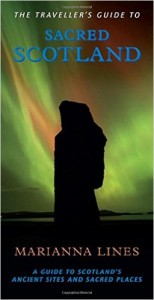 Lines, Marianna (2015) The Traveller’s Guide to Sacred Scotland: A Guide to Scotland’s Ancient Sites and Sacred Places (Glastonbury: Gothic Image Publications) paperback, i-xx, 343pp, i-v £16.99
Lines, Marianna (2015) The Traveller’s Guide to Sacred Scotland: A Guide to Scotland’s Ancient Sites and Sacred Places (Glastonbury: Gothic Image Publications) paperback, i-xx, 343pp, i-v £16.99
This attractively presented little book is one of a series that also includes titles devoted to the ancient and sacred sites of England (2003), Ireland (2002) and perhaps even more imaginatively, to Fairy Sites throughout England, Wales and Scotland (2004). Like these, its long, thin, colour-rich format is ideally suited to the glove box, the backpack or the coat pocket for ready reference in the field.
Its author, Marianna Lines, is a Fellow of the Society of Antiquaries of Scotland and a co-founder of the Pictish Art Society; but more than that she is an artist with an artist’s sensibility and a deep fascination for the spiritual, which is reflected in all her work. She is perhaps best known for her print-making techniques, employing rubbings and natural dyes to create Celtic or Pictish inspired designs on textiles and paper at her thatched studio in Collessie, Fife. As her admirers might anticipate, this guide is not intended as an academic work, but rather a friendly and informal ‘vade mecum’, designed to be easy to dip into, rather than read from cover to cover.
The book, itself, is thoughtfully organised. The preliminary material provides the reader with a detailed timeline, a glossary, an introduction and a prologue on the Picts, which reflects the author’s own personal interest in these people and their artistic legacy. However, the gazetteer consisting of more than three hundred entries forms its heart. This is sub-divided into eleven colour-coded sections, corresponding roughly to natural regions, each of which is fronted by a simple location map followed by a short preface. The writer and poet, Alastair McIntosh, provides a special introduction to the section on the Outer Hebrides. Sub-headings vary, but detailed instructions for finding the sites are not given, as clearly it is envisaged that the pilgrim should plan their own routes using an Ordnance Survey map in conjunction with the eight figure grid references that head every entry. For the most part, this is not a difficult undertaking; and besides, detailed step-by-step instructions would only take up space that might the more profitably given over to further locations.
The chosen sites and monuments are eclectic, sometimes idiosyncratic, but nonetheless always of interest and the author writes of each with an infectious and engaging enthusiasm. Moreover, the entries are often enlivened with a sparkle of humour or an appealing guilelessness. The interpretation of ‘sacred places’ is inclusive, comprising both pagan and Christian, most being briefly explored through a rich mix of history, archaeology and folklore. The author’s subjects extend from Neolithic cup and ring marked rocks to Andy Scott’s Kelpies at Falkirk (now surely vying with Alfred Gilbert’s Eros and Anthony Gormley’s ‘Angel of the North’ as the most famous piece of public sculpture in Britain) and the Tullibole Witches’ Maze, planted by Lord Moncrieff in 2003 as a memorial to the victims of the Crook of Devon witch trials of 1662.
The criteria for a site’s inclusion are not always immediately apparent, but can be usually determined from an entry’s content. Apart from those noted above, these embrace a host of subjects many of which can be anticipated, but others are perhaps less expected, such as ancient trees, curious erratics, sacred mountains, hallowed Islands, secret glens and other places that have been sanctified by lore and legend. As the choice is essentially personal, so the more interesting and elaborate sculptured stones in a region are usually carefully noted. Sometimes an entry is no more than a pointer, encouraging the reader to seek further information elsewhere; but with others, he or she is deliberately left none the wiser – a sense of mystery being the order of the day.
The illustrations are plentiful and for the most part well chosen. Although small, they serve their intended purpose well. There is usually at least one to a page and they include several of the author’s own skilful paintings and rubbings. Some of these are printed textiles, which are occasionally hung next to the original that inspired them, or in one instance wrapped around it!
A bibliography follows the gazetteer, which includes only books (with the exception of a single popular magazine article), augmented by a very small selection of websites. Given the intended readership, anyone wishing to delve deeper would be able to do so and only seven of the listed items were published before 1990. There is also a good index – a sine qua non in a book of this type. For the most part the text is happily free of typographical errors, although ‘Mary Harman’ has been transformed into ‘Mary Hannan’ in the bibliography.
While not a work intended for scholars, most should be able to find something of interest within this book’s pages. Its range is wide, yet it cannot possibly be comprehensive. However, the author would probably be more than delighted if it was to stimulate the ordinary reader towards planning their own pilgrimages to Scotland’s numinous sites.
A.T. Welfare, FSA Scot
24 July 2015
